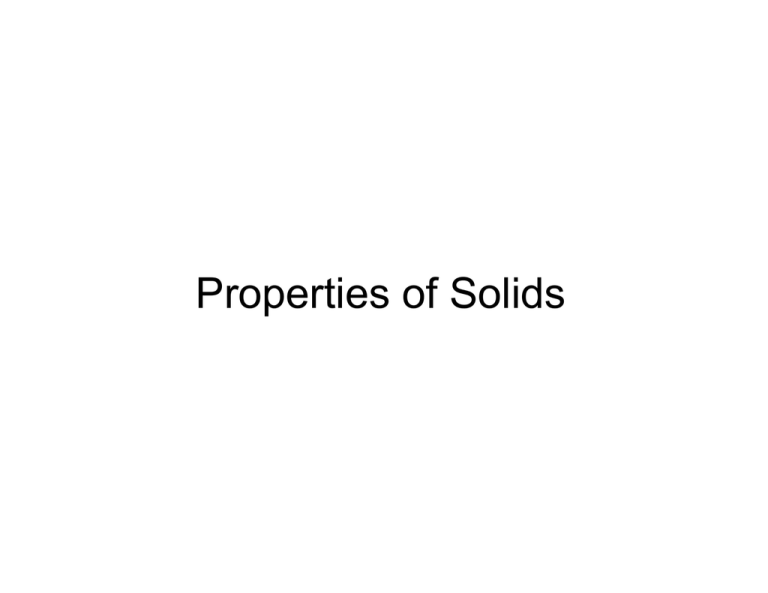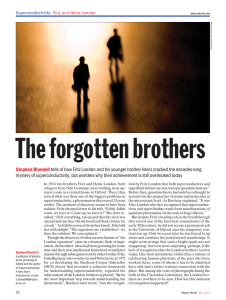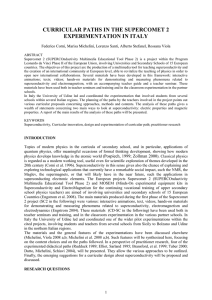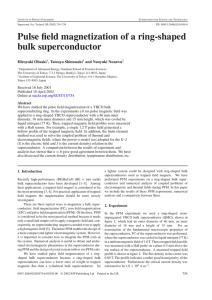Properties of Solids
advertisement

Properties of Solids Condensed Matter Physics Condensed matter physics: • The study of the electronic properties of solids. Crystal structure: • The atoms are arranged in extremely regular, periodic patterns. • Max von Laue proved the existence of crystal structures in solids in 1912, using x-ray diffraction. • The set of points in space occupied by atomic centers is called a lattice. Structural Properties of Solids • Perfect crystals are rare • Most solids are in a polycrystalline form – Made up of smaller crystal structures [from a few atoms to a few thousands atoms on a side] • Solids with no significant lattice structure are called amorphous (“without form”) – Common glass is amorphous – Amorphous solids can also be referred as “glasses” • Why solids “crystallize” ? – When the material changes from the liquid to the solid state, the atoms can each find a place that creates the minimum energy configuration. Model Pauli exclusion principle • The net potential energy felt by each ion on the crystal is the result of an attractive potential [Coulomb] and a repulsive potential [Pauli principle + overlap of the electron shells]. Madelung Constant • NaCl crystal: Attractive potential: Similar to the Coulomb force, α: Madelung constant The Madelung constant is calculated by estimating the mean-field charge surrounding a given atom. NaCl crystal: looking at Na+ - attractive force with 6 Cl- neighbors (dist=1) - repulsive force with 12 Na+ neighbors (dist=√2) - attractive force with 8 Cl- neighbors (dist=√3) -… Madelung Constant: (The Madelung constant is crystal-dependent) Net Potential • Repulsive potential: – “Screening” effect The force diminishes rapidly for r>ρ (ρ ~ range of the repulsive force) • Net force: At the equilibrium position: F = -dV/dr = 0 with ρ << r0 Example: NaCl ρ/r0 = 0.11 Thermal Expansion (in brief) I r0: equilibrium position at T=0 rT: equilibrium position at T>0 • Tendency of a solid to expand when T increases • Model: – x = r – r0, oscillations around the equilibrium position – Potential: Harmonic Oscillator Anharmonic component Thermal Expansion (in brief) II • Mean displacement using the Maxwell-Boltzmann distribution function: With β = 1/kT • After simplification (first order), calculations, etc… Thermal expansion of solid Argon Linear dependence with Temperature at first order. When T0, the first order term vanishes, need higher order terms Other properties • Thermal Conductivity: • Magnetic properties: – Ferromagnetism • Materials with a net magnetic moment even in zero applied magnetic field – Paramagnetism • Net magnetic moment only in the presence of an applied field in the direction of the field – Diamagnetism • Net (but weak) magnetic moment opposite to an applied magnetic field – Antiferromagnetism / Ferrimagnetism • Superconductivity Superconductivity • Superconductivity is characterized by the absence of electrical resistance and the expulsion of the magnetic flux from the superconductor – Zero Resistivity – First observed by Kamerlingh Onnes (1911) in solid mercury [discovery shortly after he achieved the liquefaction of Helium (T<4.2K) Tc: Critical Temperature Superconductivity • Expulsion of the magnetic flux outside of the superconductor: Meissner effect (1933) • The Meissner effect works only to the point where the critical field Bc is exceeded, and the superconductivity is lost until the magnetic field is reduced to below Bc. • To use a superconducting wire to carry current without resistance, there will be a limit (critical current) to the current that can be used. Tc(Pb)=7.2K Tc(In)=3.4K • Levitation of a cubical magnet over a superconductor BCS Theory John Bardeen Leon J. Robert Cooper Schrieffer Nobel Prize in Physics 1972 • “Cooper pairs” • Electron – Phonon interaction One result of the BCS theory • Critical magnetic field at Temperature 0<T<Tc Tc(Pb)=7.2K Tc Critical Temperature Tc(In)=3.4K Critical Field at T=0 Critical Field at T>0 High Tc • The Quest for High Tc would make everyday applications possible Good Conductor / Bad Superconductor Applications of Superconductivity (I) • Josephson Junctions / SQUIDs (Superconducting Quantum Interference Devices) – Superconductor / Insulator / Superconductor • Maglev Applications of Superconductivity (II) • Generation / Storage / Transmission of Electricity Superconductor: R=0 ! Increase V to reduce Plost • Magnetic Resonance Imaging (MRI) / Nuclear Magnetic Resonance






